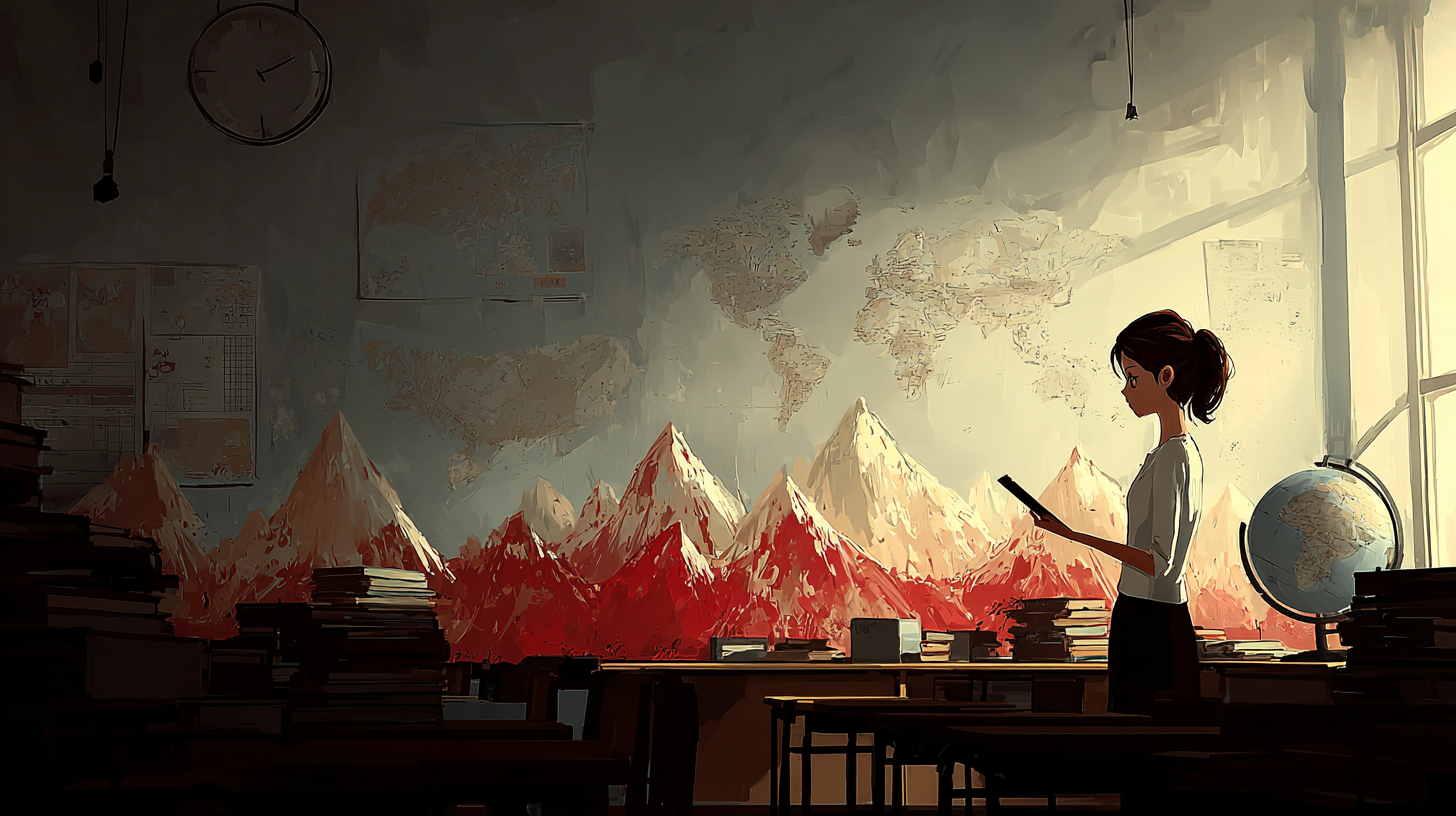“Geography” means learning about places, land, and natural features like mountains and rivers.
「geography(ジオグラフィー)」は、国や場所の形、山や川などのようすを学ぶことです。
以下は英単語 “geography” に関するストーリー型学習コンテンツです。まずは大枠の意味を理解して最後の文章で確認しましょう。
geographyの主な意味(main meaning)
| 品詞 | 意味 | 発音記号 (IPA) | 例文 |
|---|---|---|---|
| 名詞 | 地理(学)、地形、地理的特徴 | /dʒiˈɒɡ.rə.fi/ | We studied the geography of Japan in class. |
geographyの語源(etymology)
“geography” はギリシャ語の geo(地球)+ graphy(書く・記録する)に由来します。つまり「地球のようすを書くこと」が元の意味です。地球の形や場所を描く学問というイメージです。
geographyの類義語(synonyms)
| 類義語 | 例文 |
|---|---|
| topography | The topography of the island is mostly mountainous. |
| earth science | She is interested in earth science, especially volcanoes. |
| cartography | Cartography is the art of making maps. |
| geology | He studied geology to learn about rocks and minerals. |
geographyの反義語(antonyms)
| 反義語 | 例文 |
|---|---|
| history | History teaches us about past events, not places. |
| literature | Literature explores stories and language, not land features. |
geographyのコロケーション(collocations)
| コロケーション | 例文 |
|---|---|
| physical geography | Physical geography includes mountains, rivers, and lakes. |
| human geography | Human geography looks at where and how people live. |
| study geography | I will study geography for the test tomorrow. |
| geography lesson | Today’s geography lesson was about deserts. |
| geography textbook | I forgot my geography textbook at home. |
geographyの2項表現(binomials)
| 2項表現 | 例文 |
|---|---|
| maps and geography | She enjoys reading about maps and geography. |
| history and geography | History and geography are both important school subjects. |
英語ストーリー(english story)
Title: “The Geography Project”
Sana was a high school student who loved geography. She enjoyed learning about the topography of different countries and how people lived in various regions. Her favorite class was physical geography, where she learned about rivers, mountains, and deserts.
One day, her teacher gave a group assignment: “Create a presentation about a country’s geography.” Sana’s group chose Peru. While working on the project, they used a geography textbook, old maps, and even watched a documentary.
Sana focused on the human geography part, explaining how people in Peru live in cities and mountains. Another group member studied the cartography—how maps of Peru were made.
As the project continued, Sana realized that geography and history are connected. While geography shows us where, history tells us what happened there. She wrote in her report, “Understanding geography helps us understand the world better.”
The day of the presentation arrived. Their group explained Peru’s physical and human geography, used a 3D map, and even added fun facts. The teacher praised them: “This is a great combination of maps and geography. Well done!”
After class, Sana said, “I used to think geology and geography were the same. But now I know geology is more about rocks, and geography is about places.”
Her friend replied, “I prefer literature to geography. But your presentation made it interesting.”
Sana smiled. She had not only learned about Peru, but also helped others see how exciting geography can be.
和訳
タイトル:「地理のプロジェクト」
サナは高校生で、**地理(geography)が大好きでした。いろいろな国の地形(topography)や、人々がどう暮らしているかを学ぶのが好きでした。特に好きな授業は自然地理(physical geography)**で、川、山、砂漠について学びました。
ある日、先生がグループ課題を出しました。「ある国の地理についてプレゼンを作りなさい」。サナたちのグループはペルーを選びました。**地理の教科書(geography textbook)や古い地図(maps)**を使い、ドキュメンタリーも見ながら準備を進めました。
サナは**人文地理(human geography)を担当し、ペルーの人々が都市や山でどのように暮らしているかを説明しました。他のメンバーは地図製作(cartography)**について調べました。
プロジェクトを進める中で、サナは**地理(geography)と歴史(history)**がつながっていると気づきました。地理は「どこ」を教えてくれて、歴史は「何があったか」を教えてくれます。彼女はレポートにこう書きました。「地理を理解することで、世界をもっとよく理解できる」。
発表の日が来ました。彼らのグループは、ペルーの自然と人の地理を説明し、立体地図を使い、おもしろい豆知識も紹介しました。先生はほめました。「**地図と地理(maps and geography)**をうまく組み合わせた、すばらしい発表ですね!」
授業後、サナは言いました。「前は**地質学(geology)**と地理って同じだと思ってたけど、今は違いが分かるよ。地質学は岩、地理は場所のことなんだね」。
友達が答えました。「私は**文学(literature)**の方が好きだけど、サナの発表で地理もおもしろいと思ったよ」。
サナはにっこり笑いました。彼女はペルーのことだけでなく、地理の楽しさを他の人にも伝えることができたのです。
geographyのQ&A
- Q地理(geography)とtopography(地形)の違いは何ですか?
- A
地理は広く場所や環境、人々の暮らしを学ぶ学問であり、topographyは特に土地の形や高低差など、地形そのものを指します。
- Qearth science(地球科学)はgeographyの一部ですか?
- A
はい、earth scienceは地球全体の仕組みを学ぶ学問で、geographyはその中でも特に場所や環境、人間との関係に焦点を当てます。
- Qcartography(地図製作)はgeographyとどう関係していますか?
- A
cartographyは地理の一分野で、場所や地形の情報を地図として表現する技術・学問です。地理を理解するのに重要な役割を果たします。
- Qgeographyと反対の意味を持つ単語はありますか?
- A
完全な反対語はありませんが、focusが「場所」ではなく「出来事」や「物語」にあるhistory(歴史)やliterature(文学)は、学問の方向性が異なります。
- Qhistoryとgeographyはどう違いますか?
- A
historyは「いつ・何が起きたか」を学ぶ学問で、geographyは「どこ・どんな場所か」に注目する学問です。
- Q“physical geography”はどんな意味ですか?
- A
physical geographyは、山、川、海、気候など自然の地理的特徴を扱う分野です。自然の地形や環境に関する内容が中心です。
- Q“human geography”はどんなことを学ぶ分野ですか?
- A
人間地理学(human geography)は、人々がどこに住み、どんなふうに暮らしているか、文化や都市の分布など、人間の活動と場所の関係を学ぶ分野です。
- Q“study geography” という表現はどんな場面で使いますか?
- A
学校や自習で地理の勉強をするときに使います。例:”I want to study geography for the test.”(テストのために地理を勉強したい)
- Q“maps and geography” という表現はなぜよく使われますか?
- A
地理を理解するのに地図は欠かせないからです。mapsは場所を視覚的に理解するための重要なツールです。
- Q“history and geography” というペアはどうしてよく一緒に出てくるのですか?
- A
どちらも社会科で学ぶ重要な分野であり、歴史と地理は密接に関係しているからです。場所と出来事を一緒に学ぶことで理解が深まります。



コメント